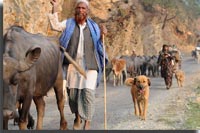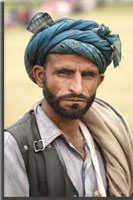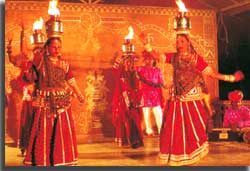Origin
The Gujjar tribals for many years have settled in the heartland of Himachal Pradesh. In all the tribal communities the Gujjars are held high in esteem. The Gujjars are also called as Goojar, Gujar & Gurjara. They are mostly residing the northern western part of Himachal Pradesh. The origin of this tribe is quite interesting as it has said it was during the time of invasion of Hunas the Gurjara tribes moved into northern India and the Himachal Pradesh. It is also assumed by another school of thought that the Khazar tribes are the Ancestors of the Gujjar Tribe.
The term Gujjar has arrived from Khazar. In India, Gujjar populations are found mainly in Delhi, Jammu and Kashmir, Himachal Pradesh, Punjab, western Uttar Pradesh, Haryana, northern Madhya Pradesh, Uttarakhand, Rajasthan, Gujarat and Maharashtra. The semi-nomadic Gujjar groups are found in the states of Jammu and Kashmir, Himachal Pradesh, and north-western Uttar Pradesh. The name for the state of Gujarat has derived from "Gurjar".
Culture
Gujjars are culturally very much depictable by dancing, religious rites and customs etc. The tribes have got inclination towards religion. Some of them have converted themselves to Hinduism and also Islam. They are the tribes who strictly follow old traditions and customs. They still follow custom of early marriages, where girls are married at an age of 14 - 15 years and boys at 17-18 years.
Occupation

There is dearth of trained Gujjar artisans in various handicrafts. Therefore, they are constantly dependent on the items needed by them from the market and the Barbers, Blacksmiths, cobblers and other artisans also move with them to various locations. These people have adopted their own way of life and Gujjars have accepted them as part of their social group.
People

Topi which is also called as Afgani hat is worn by the aged Gujjar men. Gujjar females have greatly enhanced beautiful clothes called Duppatta which looks like a shawl.
They are also fond of jewellery and have a fascination for the necklace with a triangle pendant, studded with a beautiful stone in the center of it. It symbolizes 'evil eye' and mainly utilized to avert bad luck.
Place /Location (then and now) |
Himachal Pradesh & Jammu and Kashmir |
Population |
55 lakhs in Jammu and Kashmir & Himachal Pradesh |
Languages spoken |
Gojri, Punjabi, Hindi, Urdu,, English |
Religion/God |
Hinduism, Islam Sikhism
|
Food |
Veg and Non Veg , wheat , cereals |
Food
Mostly they depend on milk products as their staple food besides cereals, wheat and maize. They may be vegetarians and non-vegetarians as well. The favorite dishes of Gujjar are "Maki ki Roti" Ganhar / Sarssoon ko Sag, Lassi, Kalari, Karan, etc.It is surprising that Gujjar are mostly vegetarians.The Banhara Gujjars mainly live in "Kullas" made from Special type of grass, while Bakerwals live in temporary Doharas and in Tamboos. Settled Gujjars mainly live in "Kothas"
Language
The Gujjar tribal community has the beautiful language of Gujari also called as Gojri. The language belongs to the Rajasthani language group. The communities have also developed fluency in other languages such as Punjabi, Urdu, Hindi, Pastho, Pahari languages like Kangri and Dogri.
Festivals

The Government of India has set up various commissions from time to time for identification of various weaker communities so that data and other necessary information could be collected in respect of their educational, social, economic and political status and on the basis of such datas and resultant recommendations, such downtrodden communities could be provided avenues for development and progress.
A few of such commissions which have played vital and historical role include Gajendragadkar Commission, the Sikri Commission, the Wazir Commission (1969), the Anand Commission (1976) and the Mandal Commission which covered the entire country.
Economy
Gujjar Tribe has always been an exploited component with Gujjar politics which is related to the poor economic condition of this down trodden community. The basic characteristics of Gujjar Economy is:
- Labour Class
- Agriculture Class
- Service Class
- Business Class
- Dealing with Milk and Milk Products
- Dealing with Mutton and Woollen products
- Other business related Activities
- Artisans Class: The people associated with professional handicrafts, handloom and all semi-skilled activities.


